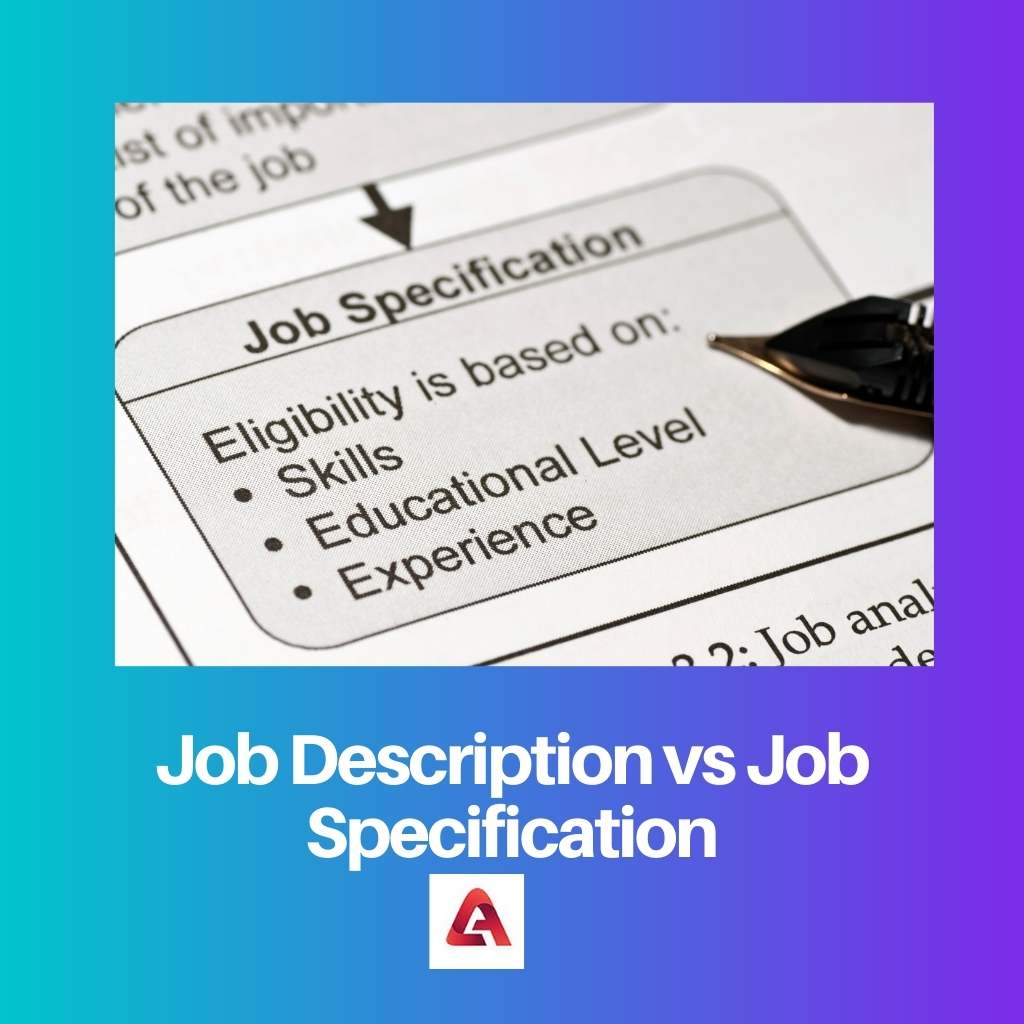Job analysis provides an overview of skills and qualifications that are expected from the candidates applying for the job position. Job analysis can be further classified into two main types: job description and job specification.
Key Takeaways
- A job description outlines a position’s roles, responsibilities, and expectations, while a job specification details the qualifications, skills, and experience required.
- Job descriptions help applicants understand their duties, whereas job specifications guide employers in selecting the right candidate.
- Job descriptions remain relatively constant, while job specifications may change based on a company’s evolving needs.
Job Description vs Job Specification
A job description includes the job title, location, job overview, working environment, job duties, etc. A job specification outlines an individual’s qualifications, experience, training, skills, emotional characteristics, and mental capacities to execute the job.

The job description contains the details like qualifications required by the candidates for the position, knowledge about the skills, tools, or aids that should be used at work, physical demands, salary range, and even working conditions.
The determining factor of whether the candidate is suitable for the accomplishment of the goals related to the position can be done through jobs specification.
Comparison Table
| Parameters of Comparison | Job Description | Job Specification |
|---|---|---|
| Definition | Job description contains detailed information about the job position like title, duties, responsibilities, job location, role in a format | Job specification contains a set of information like qualities, experience, qualifications, the knowledge that are essential for the candidate to perform the job role |
| Origin | Job description has originated from job analysis | Job specification has originated from the job description |
| purpose | Job description provides the essential description of the job profile | Job specification provides the eligibility criteria for the candidates of the job profile |
| Elements | Provide details like job title, job role, job location, responsibilities, allowances, duties, salary, and incentives | Provides details like knowledge, attributes, skills, qualification, experience, and other requirements |
| Relationship with the organization | Job description provides insights about the offerings of the company to the candidate | Job specification provides the expectation of the company from the candidates |
What is a Job Description?
It contains the details like qualifications required by the candidates for the position, knowledge about the skills, tools, or aids that should be used at work, physical demands, salary range, and even working conditions.
The job description can be related to job analysis which examines the sequences and tasks which are required by the candidate to perform in the job position. Job descriptions are in narrative form and can also contain a list of competencies.
The main use of job descriptions is by employers during the recruitment process. The job description can also contain the relationship factor with other co-workers of the organization, like that of managerial level, supervisory level, and other related requirements.
It can include probable promotion conditions and routes. Job descriptions can be inflexible in certain organizations, which are rapidly changing. Senior-level recruitment may cause hindrances in freedom of choice and direction through job description.
What is Job Specification?
Job specification refers to the skills, knowledge, and abilities that are required to perform a certain job position in any organization. The job specification for any specific role can include aspects like work experience, education, managerial experience, and personality traits which help in evaluating the candidate for the role.
Job specification plays an essential role in any organisation’s selection and recruitment process. It is also helpful in evaluating the performance of the employees and can further play a role in the promotion and appraisal of the employee.
Job specifications contain specific details of the position of the job. The four main parameters are educational qualification, experience, skillset and knowledge, and personality characteristics and traits. Job specification focuses on all these four parameters.
Job specification essentially highlights all the minute details that the potential candidates require. It also provides a threshold for recruiting managers. It builds a framework based on which the prospects can be selected.
Main Differences Between Job Description and Job Specification
- Job description refers to the company’s offering to the candidate, while job specification refers to the company’s expectations from the candidate.
- A job description aims to provide relevant and enough information about the job role, while a job specification aims to evaluate the right candidate for the job role.

- https://etd.lis.nsysu.edu.tw/ETD-db/ETD-search/view_etd?URN=etd-0908108-150640
- https://en.cnki.com.cn/Article_en/CJFDTotal-ZXGL201411021.htm

The article provides a deep understanding of what a job description and job specification are. I appreciate this detailed source of information.
This article does a great job at breaking down the differences between job descriptions and job specifications. I can definitely see how this could be useful for companies when hiring.
This is a very informative explanation of job descriptions and job specifications. It is very helpful for employers, employees, and job seekers too.
There seems to be an overlap between job description and job specification, with specific examples given in this article. However, I believe it could have been presented in a more concise manner.
The comparison table for job description and job specification is very effective in highlighting the differences. This will be a valuable resource for HR professionals and job seekers.
I disagree with the concept that job descriptions remain relatively constant, as these can also evolve based on the company’s needs and changes in roles.